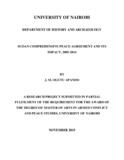| dc.description.abstract | This study examines the Sudan Comprehensive Peace Agreement (hereafter CPA) and its impact, 2005-2014. The study recognizes the fact that despite the signing of the CPA between the Government of Sudan (hereafter GoS) and the Sudanese Peoples Liberation Movement/Army (hereafter SPLM/A), and successful secession of South Sudan, the conflict between Sudan and South Sudan seem to be far from over. The failure to translate the CPA to end the conflict in Sudan and South Sudan raises the question whether the CPA was comprehensive and whether it was implemented or not and, the impact of its implementation/lack of implementation.
The study is guided by three main objectives: to examine the Sudan peace processes and the formulation of the CPA; to assess the implementation of the CPA in Sudan/South Sudan and; to evaluate the impact of the CPA in Sudan and South Sudan. The study employed the following three research hypotheses: the formulation and implementation of the CPA was influenced by the interests of belligerents, the CPA did not address long term structural problems in Sudan/South Sudan and, the poor implementation of the CPA led to the failure of its mission. The theoretical framework combines insights from two different perspectives focusing on structural and systemic theories. Conflicts in Sudan were considered embedded on unjust and non-equitable legal, political, social and economic structures. The impact of these conflicts transcended the regional and international boundaries, leading to the intervention of the IGAD into the conflict.
The research employed both secondary and primary data but relied mostly on secondary data. The secondary sources used were books and journals articles, print and electronic media and other relevant papers. The primary sources utilized were mainly the Sudan CPA, oral interviews of the people identified and the use of questionnaires. Sampling of respondents was through purposive and snowballing method. The data collected was analysed using qualitative approach. This method provided ways of examining, comparing and interpreting themes on which conclusions were drawn. The results are shown in terms of explanation in a narrative form.
The study reveals that though the CPA brought an end to the Sudanese North-South civil war, neither peace nor democracy have been achieved in Sudan and South Sudan. Instead, conflict is still persistent in many areas of Sudan and South Sudan since the end of the civil war. The study
vi
shows that the conflict in the two countries is the direct result of the failure of the CPA to address Sudan‟s issue of sovereignty beyond the North/South divide, both in its design and implementation.
Six years after the signing of the CPA, a referendum was held in the South and close to 99% voted for independence. South Sudan became a republic on July 9, 2011. Constructing a new nation still recovering from a civil war has been a challenge for South Sudan. These include, interalia, security issues, poverty, economic productivity, and the development of human resources, service delivery, resettlement and reintegration of IDPs/returnees/refugees, DDR and the establishment of democratic institutions to ensure popular participation in the government. The end of the struggle with the North not only deprived Southern leaders of their historic common enemy, but also opened the way for internal divisions to re-emerge. Security was a major concern in the North-South relationships in the implementation of the CPA. An effort to construct a security system that guarantees political stability and economic prosperity between and within the countries has continued to be a challenge. Following the secession of South Sudan, the Khartoum government has had to determine how to govern alongside a new country carved out of it. The loss of oil revenue following the separation of the South has had a negative impact in the budget, presenting a huge economic and political challenges to the government.
Taken together, these findings will build a deeper understanding of the Sudan CPA for the purposes of informing other research being carried out over the next several years. The study hopes to make a contribution by providing additional and novel insight in the implementation and impact of the CPA in Sudan and South Sudan. The research will, therefore, be of both scholarly and policy importance. | en_US |

